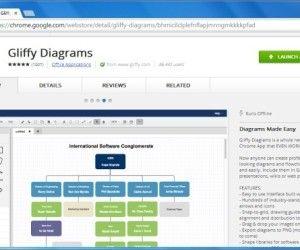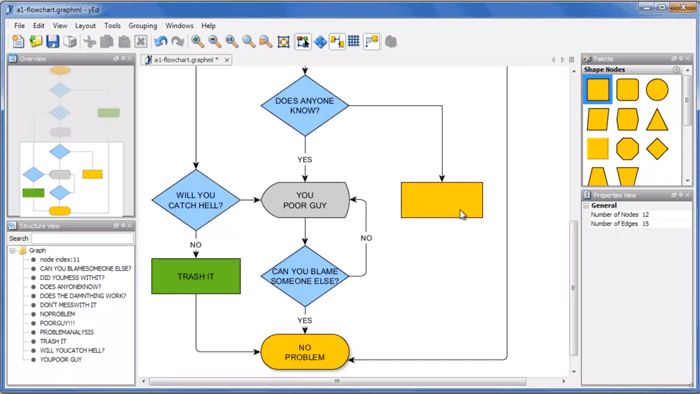Gliffy is software for diagramming via an HTML5cloud-based app. It is used to create UML diagrams, floor plans, Venn diagrams, flowcharts and various other kinds of diagrams online. Gliffy diagrams can be shared with and edited by users in real time. The SaaS is supported in all modern web-browsers, including Google Chrome, Firefox, Safari and Internet Explorer 9+.

Version: 3.7.59-add7e75.5588.
Gliffy's developer, the self-funded company Gliffy, Inc., was acquired by Rogue Wave Software in October 2018, and Rogue Wave was subsequently acquired by Perforce Software in January 2019.[1][2]
- Point of pride: Gliffy is the most popular cloud diagramming and drawing app in the Atlassian Marketplace. And for good reason. Start a free trial or learn how to request one today. Developers, project managers, system admins, and teams can swap expensive desktop tools for Gliffy.
- Gliffy's diagramming software was built by a pair of engineers who wanted all the ease of drawing diagrams on a whiteboard packed into one powerful app. If you need a flowchart maker for your business, a wireframing app for a design project, or a diagramming tool for a software engineering team, Gliffy has your back.
- The Gliffy diagramming App is easy to use and even WORKS OFFLINE. You’ll find shapes to create: flowcharts org charts UML ERD network diagrams UI more You can save Gliffy Diagrams in JPEG, and PNG formats and add them to Google Docs, presentations, wikis or webpages.
History
Gliffy was founded in 2005 by friends and former coworkers, Chris Kohlhardt and Clint Dickson. The two software engineers saw a need for an online diagramming tool and decided to leave their full-time jobs and start a company to develop it.[3] Kohlhardt contacted Mike Cannon-Brookes, one of the founders of Atlassian, an Australian enterprise software company. With his encouragement, Kohlhardt and Dickson created a Gliffy plugin for Atlassian’s collaboration product Confluence, and business took off.[4] In May 2006, Gliffy announced its public beta and by 2007 the beta was removed. In 2009, a new Gliffy plugin for Atlassian's JIRA product was unveiled and in 2010 Gliffy was added to the Google Apps marketplace. In early 2013, Gliffy moved to an all HTML5 platform,[5] at the same time adding Visio support.[6] Gliffy integrates with Google Apps, Google Drive, JIRA, and Confluence, and has over two million registered users.[citation needed] It was acquired by Rogue Wave Software in October 2018, which was then acquired by Perforce in January 2019.[7][2][1]
Timeline
- August 2006: Gliffy adds UML shapes
- November 2006: Gliffy Plugin for Atlassian Confluence unveiled
- February 2007: Beta removed
- January 2009: Gliffy Plugin for Atlassian Jira unveiled
- July 2010: Gliffy added to Google Apps marketplace
- January 2012: Gliffy reaches 1 million users[citation needed]
- October 2012: Gliffy moves to HTML5[8]
Features

Gliffy features a drag-and-drop interface and real-time online collaboration and sharing capabilities. It allows users to export their diagrams in multiple formats including: PDF, JPEG, PNG and SVG. It is supported in all modern web browsers, including Google Chrome, Firefox, Safari, and Internet Explorer 9+.
Gliffy integrates with Google Apps, Google Drive, Jira, and Confluence.
Gliffy Application Download
See also
References
- ^ ab'Rogue Wave Software Acquires Gliffy'. Megr. 2018-10-31. Retrieved 2020-09-20.
- ^ ab'Perforce expands DevOps portfolio with Rogue Wave acquisition'. sdtimes.com. 2019-01-22. Retrieved 2020-09-20.
- ^'Gliffy, the online Visio killer'. CNET. Retrieved 11 October 2014.
- ^'5 Desktop Apps to Help Run Your Business Better'. September 3, 2014.
- ^'A Platform Play – Gliffy Moves Its Online Diagram Service To HTML5 And Says Goodbye To Flash'. TechCrunch. 31 October 2012. Retrieved 11 October 2014.
- ^'Gliffy goes HTML5, adds Visio support'. June 12, 2013.
- ^'Gliffy: bootstrapped in San Francisco'. ZDNet. 27 November 2012. Retrieved 11 October 2014.
- ^'How Gliffy is managing the risk of re-writing their product in HTML5'. April 19, 2012.
Gliffy App Store
